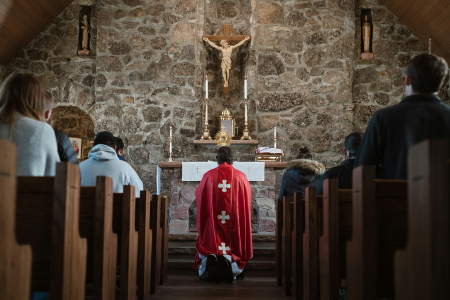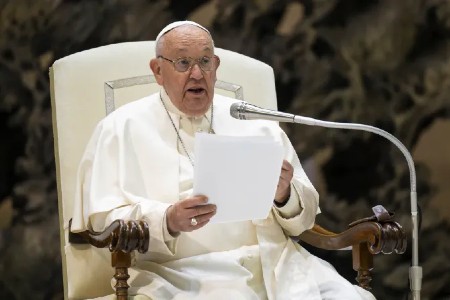 Hi readers, it seems you use Catholic Online a lot; that's great! It's a little awkward to ask, but we need your help. If you have already donated, we sincerely thank you. We're not salespeople, but we depend on donations averaging $14.76 and fewer than 1% of readers give. If you donate just $5.00, the price of your coffee, Catholic Online School could keep thriving. Thank you. Help Now >
Hi readers, it seems you use Catholic Online a lot; that's great! It's a little awkward to ask, but we need your help. If you have already donated, we sincerely thank you. We're not salespeople, but we depend on donations averaging $14.76 and fewer than 1% of readers give. If you donate just $5.00, the price of your coffee, Catholic Online School could keep thriving. Thank you. Help Now >
Ghent
FREE Catholic Classes
DIOCESE OF GHENT (GANDENSIS or GANDAVENSIS).
The Diocese of Ghent at present comprises the whole territory of East Flanders, one of the nine provinces of Belgium. It numbers 1,103,930 inhabitants and 362 parishes. The see was erected by Paul IV ("Super universi", 12 May, 1559) at the request of Philip II , King of Spain and Sovereign of the Low Countries. Till that time Ghent had belonged to the Diocese of Tournai. Situated on the left bank of the Scheldt (Escaut), the new diocese was bounded on the north by the western arm of that river, on the east by the new Dioceses of Antwerp and Mechlin, detached from Cambrai, on the south by Tournai, and on the west by the new Diocese of Bruges ("Ex injuncto", Pius IV, 1560, and "Regimini universalis Ecclesiae" especially for Ghent, 7 August, 1561). Previous to this Charles V had obtained from Paul III the secularization of the monks of the Abbey of Saint-Bavon, at Ghent (22 July, 1536), and in 1541 they transferred their chapter from the ancient abbey to the parochial church of St. John the Baptist, which henceforth bore the name of Saint-Bavon. In 1559 it was decided that this chapter should become that of the cathedral, and that at the death of Viglius, then mitred provost of said chapter, the revenues of the abbacy, or provostship, should become the episcopal revenues.
After the concordat between Pius VII and the First Consul, Bonaparte, the pope called upon all the bishops of France to resign their sees. Prince de Lobkowitz, the Bishop of Ghent, had died at Münster in 1795 and had not been replaced. By the Bull "Qui Christi Domini" (29 November, 1801), Pius VII suppressed all the ancient dioceses throughout the French Republic, and erected sixty new dioceses, among which he re-established that of Ghent, comprising the two departments of Escaut and Lys, i.e. the three ancient dioceses of Ghent, Bruges, and Ypres, to which was added a portion of Mechlin and Dutch Flanders. Gregory XVI detached the part appertaining to Holland (25 August, 1832), and by the erection of the See of Bruges (27 May, 1834), determined the present jurisdiction of the Diocese of Ghent. Ghent has had twenty-four bishops, of whom the last is Mgr Antoine Stillemans, consecrated 27 January, 1890. Among them, Cornelius Jansenius and Antoine Triest are deserving of more special notice.
The former, who must not be confounded with Jansenius, Bishop of Ypres, the author of the "Augustinus", was professor of theology at Louvain when Philip II sent him as his representative to the Council of Trent. On his return to Flanders, he was named by the king first Bishop of Ghent, in 1568, and this nomination was confirmed by Pius IV on 6 July of the same year. His numerous and learned commentaries on the Holy Scripture reveal in him an exegete of great merit. The seventh bishop, Antoine Triest, occupied the see from 1622 to 1657. He was a veritable Mæcenas and the cathedral of Saint-Bavon is indebted to him for most of the masterpieces which adorn it. His generosity towards the poor found expression in important charitable foundations and in the zeal which he displayed in the establishment at Ghent of the Mont de Piété, an institution founded to lend to the poor without interest. Bishop Triest bequeathed considerable sums to this work. In 1813, during the episcopate of the Prince de Broglie (1807-1821), the seminarians of Ghent offered an heroic resistance to the despotism of Napoleon. The emperor held the bishop prisoner and twice sought to wrest from him his resignation. He undertook to name a successor, and sent as Bishop of Ghent a canon of Dijon, M. de la Brue de Saint-Bauzille, but all the clergy, with the exception of thirty out of a thousand priests, refused to recognize him. Being called upon to submit to the intruder, the seminarians opposed an energetic refusal, were compelled to enter the imperial regiments, and were taken, some to Wesel, the others to Paris. Many subsequently died at Wesel as a result of contagious diseases and privations of every sort, but remained faithful to their motto: "Rather soldiers than schismatics ".
During the episcopate of Mgr Delebecque (1838-64) nine American bishops sent two of their colleagues to ask priests from the Diocese of Ghent, intending to place under their direction and instruction the seminary which they proposed to found at Troy, New York. Mgr Delebecque acceded to this request, and in the month of August, 1864, MM. van den Hende, Gabriels (now Bishop of Ogdensburg ), Roelants, and Puissant embarked for America. The Diocese of Ghent continued its collaboration in the seminary at Troy until July, 1896. It was also at Ghent and under the auspices of Mgr Delebecque that the work was founded, in 1859, which is now known as le Denier de Saint Pierre , i.e. Peter's Pence.
Among the clergy of Ghent Jean-François Van de Velde (1743-1823) is most deserving of notice. While he acquired a well-merited reputation as professor of Holy Scripture at the University of Louvain, and his published and manuscript works place him in the front rank of the theologians of his time, he is chiefly entitled to notice for the important part which he played in the religious affairs of his country, first, under Joseph II, by his intrepid opposition to the decrees with regard to marriage (1784), and later, under Napoleon, by his decisive intervention at the national council, which the emperor assembled at Paris in 1811, and where, as the counsellor of Mgr de Broglie, he presented a "Mémoire sur l'incompétence du concile national à changer la discipline de l'Eglise, en vertu de laquelle le Pape seul donne l'institution canonique aux évêques nommés" (Memorandum concerning the incompetency of the national council to alter the discipline of the Church, in virtue of which the pope alone confers canonical institution on the nominated bishops ).
One who was well entitled to be called "the Vincent de Paul of Belgium " also deserves mention. The inexhaustible charity of Canon Pierre-Joseph Triest (1760-1836) was extended to all human miseries, and for their more efficacious relief he founded in succession the Sisters of Charity (1803), the Brothers of Charity (1807), the "Association of Maternal Charity" (1822), the Brothers of St. John of God (1825), and the Sisters of the Holy Childhood of Jesus (1835).
We shall speak only of the first and second of these institutions, the development of which was truly extraordinary. The Sisters of Charity now number more than 1300, and their benevolent activity is spread throughout Belgium, Holland, England, the Congo, India (Punjab), and Ceylon, they are engaged not only in the instruction of children, but give intelligent and devoted care to deaf mutes, the insane and incurables. In Europe more than 6000 infirm are sheltered in their houses. The Congregation of the Brothers of Charity, which numbers about 1000 religious, is spread throughout Belgium and has been extended successively to Canada, the United States, England, Ireland, and the Netherlands. At present it possesses 44 establishments where more than 6000 insane, aged, and sick persons and many other unfortunates are cared for. The Brothers teach and care for more than 11,000 children and poor youths, 440 deaf mutes and blind persons, 450 youthful delinquents and 1000 foundlings.
Truly remarkable religious monuments of the diocese are: the cathedral of Saint-Bavon and the churches of Saint-Nicholas, Saint-Jacques, and Saint-Michel at Ghent, the church of Saint-Martin at Alost, and the churches of Notre-Dame and Sainte-Walburge at Oudenarde. From an architectural point of view the cathedral of Saint-Bavon at Ghent is one of the most beautiful churches in Belgium and is undoubtedly the richest in objects of art. Among its numerous works of sculpture the tomb of Bishop Triest, by Jérôme Duquesnoy, is incontestably the masterpiece, and has been rightfully called "the most beautiful work of national statuary". The cathedral of Ghent is deservedly famous for the immortal altar-piece of the brothers Hubert and Jan Van Eyck, known as "The Adoration of the Lamb", which was completed in 1432. The cathedral now possesses only the central panel of the picture, the most important portion of the work. The side panels are at Berlin and at Brussels. [ Note: The Ghent alterpiece, after many trials and tribulations during reformation and two world wars, is on display in the Ghent Cathedral (Saint Bavo). In 1934 the panel depicting the Just Judges was stolen and never recovered. It is now substituted with a copy.]
 Hi readers, it seems you use Catholic Online a lot; that's great! It's a little awkward to ask, but we need your help. If you have already donated, we sincerely thank you. We're not salespeople, but we depend on donations averaging $14.76 and fewer than 1% of readers give. If you donate just $5.00, the price of your coffee, Catholic Online School could keep thriving. Thank you. Help Now >
Hi readers, it seems you use Catholic Online a lot; that's great! It's a little awkward to ask, but we need your help. If you have already donated, we sincerely thank you. We're not salespeople, but we depend on donations averaging $14.76 and fewer than 1% of readers give. If you donate just $5.00, the price of your coffee, Catholic Online School could keep thriving. Thank you. Help Now >
We ask you, humbly: don't scroll away.
Hi readers, it seems you use Catholic Online a lot; that's great! It's a little awkward to ask, but we need your help. If you have already donated, we sincerely thank you. We're not salespeople, but we depend on donations averaging $14.76 and fewer than 1% of readers give. If you donate just $5.00, the price of your coffee, Catholic Online School could keep thriving. Thank you.Help Now >
Join the Movement
When you sign up below, you don't just join an email list - you're joining an entire movement for Free world class Catholic education.
-

-
Mysteries of the Rosary
-
St. Faustina Kowalska
-
Litany of the Blessed Virgin Mary
-
Saint of the Day for Wednesday, Oct 4th, 2023
-
Popular Saints
-
St. Francis of Assisi
-
Bible
-
Female / Women Saints
-
7 Morning Prayers you need to get your day started with God
-
Litany of the Blessed Virgin Mary
U.S. Catholic Parishes Experience Resurgence of Traditional Practices
-

Pope Francis Urges Faith and Prayers for Peace
-

Florida Welcomes Volunteer Chaplains to Public Schools
-
10 Fascinating Details About St. Joseph the Worker: Celebrating His Feast Day - May 1
-
St. Joseph the Worker: Model for Men, Young and Old
Daily Catholic
 Daily Readings for Thursday, May 02, 2024
Daily Readings for Thursday, May 02, 2024 St. Athanasius: Saint of the Day for Thursday, May 02, 2024
St. Athanasius: Saint of the Day for Thursday, May 02, 2024 The Our Father: Prayer of the Day for Thursday, May 02, 2024
The Our Father: Prayer of the Day for Thursday, May 02, 2024- Daily Readings for Wednesday, May 01, 2024
- St. Marculf: Saint of the Day for Wednesday, May 01, 2024
- To Saint Peregrine: Prayer of the Day for Wednesday, May 01, 2024
![]()
Copyright 2024 Catholic Online. All materials contained on this site, whether written, audible or visual are the exclusive property of Catholic Online and are protected under U.S. and International copyright laws, © Copyright 2024 Catholic Online. Any unauthorized use, without prior written consent of Catholic Online is strictly forbidden and prohibited.
Catholic Online is a Project of Your Catholic Voice Foundation, a Not-for-Profit Corporation. Your Catholic Voice Foundation has been granted a recognition of tax exemption under Section 501(c)(3) of the Internal Revenue Code. Federal Tax Identification Number: 81-0596847. Your gift is tax-deductible as allowed by law.









 Daily Readings for Thursday, May 02, 2024
Daily Readings for Thursday, May 02, 2024 St. Athanasius: Saint of the Day for Thursday, May 02, 2024
St. Athanasius: Saint of the Day for Thursday, May 02, 2024 The Our Father: Prayer of the Day for Thursday, May 02, 2024
The Our Father: Prayer of the Day for Thursday, May 02, 2024

